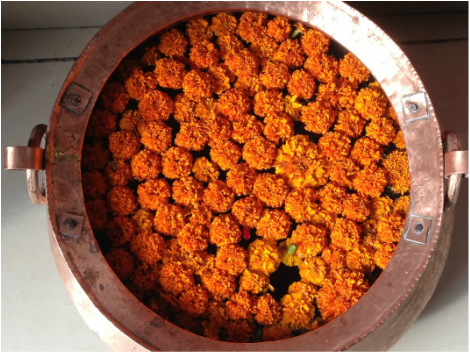
Ayurveda is a 5,000 year-old system of natural healing that has its origins in the Vedic culture of India. Tibetan medicine and Traditional Chinese Medicine are both believed to have their roots in Ayurveda.
Ayurveda is a science of life (Ayur = life, Veda = science or knowledge). It offers wisdom designed to help people stay vital while realizing their full human potential. Ayurveda reminds us that health is the balanced and dynamic integration of the environment, body, mind, and spirit. This practice provides guidelines for ideal daily and seasonal routines, diet, behavior and the proper use of the five senses.
Ayurveda describes three fundamental energies that govern inner and outer environments: movement, transformation, and structure. Known in Sanskrit as Vata (Wind), Pitta (Fire), and Kapha (Earth), these primary forces are responsible for the characteristics of an individual’s mind and body. Each person has a unique proportion of these three forces that shapes our nature. According to Ayurveda, each individual inherits a unique mix of the three mind/body principles, which creates specific mental and physical characteristics. These three principles are called Doshas.
Most of us have one or two Doshas that are most lively in our nature, with the remaining one(s) less significant. The three Doshas are known as Vata, Pitta, and Kapha. If Vata is dominant in our system, we tend to be thin, light, enthusiastic, energetic, and changeable. If Pitta predominates in our nature, we tend to be intense, intelligent, and goal-oriented and we have a strong appetite for life. When Kapha prevails, we tend to be easy-going, methodical, and nurturing. Although each individual person has all three forces, most people have one or two elements that predominate.
For each element, there is a balanced and imbalanced expression. When Vata is balanced, a person is lively and creative, but when there is too much movement in the system, a person tends to experience anxiety, insomnia, dry skin, constipation, and difficulty focusing. When Pitta is functioning in a balanced manner, a person is warm, friendly, disciplined, a good leader, and a good speaker. When Pitta is out of balance, a person tends to be compulsive, irritable and may suffer from indigestion or an inflammatory condition. When Kapha is balanced, a person is sweet, supportive, and stable, but when Kapha is out of balance, a person may experience sluggishness, weight gain, and sinus congestion.
An important goal of Ayurveda is to identify a person’s ideal state of balance, determine where one is out of balance, and offer interventions using diet, herbs, aromatherapy, massage treatments, music, meditation and yoga. A daily Ayurvedic routine is the practice of self-care, and by creating time for self-care one is expressing self-love.
Ayurveda is a science of life (Ayur = life, Veda = science or knowledge). It offers wisdom designed to help people stay vital while realizing their full human potential. Ayurveda reminds us that health is the balanced and dynamic integration of the environment, body, mind, and spirit. This practice provides guidelines for ideal daily and seasonal routines, diet, behavior and the proper use of the five senses.
Ayurveda describes three fundamental energies that govern inner and outer environments: movement, transformation, and structure. Known in Sanskrit as Vata (Wind), Pitta (Fire), and Kapha (Earth), these primary forces are responsible for the characteristics of an individual’s mind and body. Each person has a unique proportion of these three forces that shapes our nature. According to Ayurveda, each individual inherits a unique mix of the three mind/body principles, which creates specific mental and physical characteristics. These three principles are called Doshas.
Most of us have one or two Doshas that are most lively in our nature, with the remaining one(s) less significant. The three Doshas are known as Vata, Pitta, and Kapha. If Vata is dominant in our system, we tend to be thin, light, enthusiastic, energetic, and changeable. If Pitta predominates in our nature, we tend to be intense, intelligent, and goal-oriented and we have a strong appetite for life. When Kapha prevails, we tend to be easy-going, methodical, and nurturing. Although each individual person has all three forces, most people have one or two elements that predominate.
For each element, there is a balanced and imbalanced expression. When Vata is balanced, a person is lively and creative, but when there is too much movement in the system, a person tends to experience anxiety, insomnia, dry skin, constipation, and difficulty focusing. When Pitta is functioning in a balanced manner, a person is warm, friendly, disciplined, a good leader, and a good speaker. When Pitta is out of balance, a person tends to be compulsive, irritable and may suffer from indigestion or an inflammatory condition. When Kapha is balanced, a person is sweet, supportive, and stable, but when Kapha is out of balance, a person may experience sluggishness, weight gain, and sinus congestion.
An important goal of Ayurveda is to identify a person’s ideal state of balance, determine where one is out of balance, and offer interventions using diet, herbs, aromatherapy, massage treatments, music, meditation and yoga. A daily Ayurvedic routine is the practice of self-care, and by creating time for self-care one is expressing self-love.
